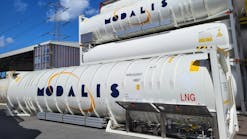The US Department of Energy (DOE) launched the Save Energy Now LEADER Program in October 2009 as a challenge to the nation's industrial sector. Volvo Trucks North America and 31 other companies pledged to reduce their intensity of energy per unit of production by 25% over a decade.
“Volvo met the Save Energy Now target in one year instead of ten,” said Chief Operating Officer Patrick Collignon, who served as vice-president and general manager of the New River Valley (NRV) plant while the target was being met.
The plant reduced its MMbtu per truck (the DOE metric for energy intensity) from 79.64 in 2009 to 60.42 in 2010 — a reduction of 29.6%.
“We reduced our total electricity consumption by 28% and natural gas consumption by 35% since the energy team was started,” said Collignon.
Every Volvo truck sold in North America is assembled at the NRV plant. Since introducing No Regen SCR aftertreatment technology to meet current EPA standards, Volvo Trucks has improved fuel efficiency of its trucks by up to 8% or more, with near-zero regulated emissions.
To reach the energy reduction goals, Volvo Trucks took advantage of DOE assessments, established a dedicated energy team at the NRV plant, and worked to make energy savings part of the employee mindset.
A detailed energy map was developed, clarifying where and how energy was being used. Team members agreed to pursue many small energy-saving tactics and attack the biggest energy-consuming process: the paint operation.
The energy team worked closely with paint shop employees to find ways to make energy-intensive processes more efficient, including optimizing stop and start times.
Other companywide efforts include use of a building automation system to control building temperatures and turn off lighting, a passive solar wall, and photovoltaic solar panels. Skylights, new light fixtures, infrared heaters, and solar water heaters were installed. As savings were found, those funds were reinvested in other energy reduction strategies.
Volvo Trucks' energy team has already identified a number of other opportunities for improvement and expects a further 10% to 20% reduction in energy intensity in 2011. The plant is also pursuing ISO 50001 certification and working to become carbon-neutral within two years.








